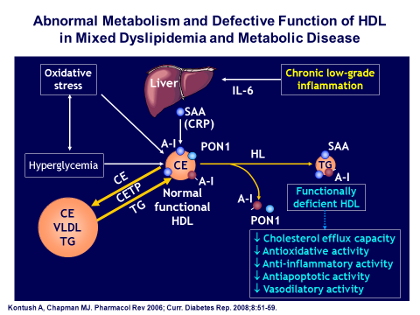Chapman - Figure 17 - Defective HDL function Text
In individuals who present with several cardiometabolic risk factors – eg, insulin resistance, chronic low grade inflammation, and either metabolic syndrome or type 2 diabetes – there are several detrimental effects: First, as a result of the chronic, low-grade inflammation
- serum amyloid is known to bind to HDL and appears to displace apoA-I, which may be lost via the kidneys;
- chronic low grade inflammation drives production of acute phase proteins in the liver, and can trigger loss of apoA-I, resulting in subnormal levels of that protein in the circulation.
Second, in addition to inflammation, which impacts HDL structure and function, oxidative stress may oxidize the lipids, particularly the phospholipids, which then become pro-inflammatory, and may also inactivate apoA-I and other proteins present in the HDL proteome. So oxidative stress is another major component that may lead to defective HDL function as a result of modification of both lipids and proteins.
Third, hyperglycemia, particularly in poorly controlled diabetics, is able to lead to glycation of apoA-I and other proteins, and we know that glycation results in the loss of the biological activities of those proteins.
Finally, in individuals with even moderate elevation of triglyceride – ie, VLDL – the cholesterol-ester transfer protein (CETP) pathway loads triglyceride into HDL particles, removes the nonatherogenic cholesterol and transfers it into VLDL particles, which then become more atherogenic, with a greater cholesterol load. Hepatic lipase degrades the triglyceride that has been loaded into the HDL particles, they become smaller, and we know that some of those particles are then removed efficiently and degraded in the kidney, thus further decreasing the presence of HDL in the circulation.
All of these mechanisms together act on a background of cardiometabolic disease to lead to functionally defective, small HDL particles that are also present in the circulation at subnormal concentrations. As listed in the box in the bottom right-hand corner of the Figure, there is clear evidence in the literature for:
- reduction in cholesterol efflux capacity,
- reduction in antioxidative and anti-inflammatory activity
- reduction in anti-apoptotic activity,
- reduction in protection of endothelial cells from oxidative stress,
- reduction in the ability of HDL to protect nitric oxide, so the vasodilatory activity of HDL is also attenuated.
All of these deleterious changes take place on the background of multiple risk factors that are typically seen in individuals with cardiometabolic disease, and especially in those with type 2 diabetes or metabolic syndrome.
J Clin Lipidol. 2011; 5(6).